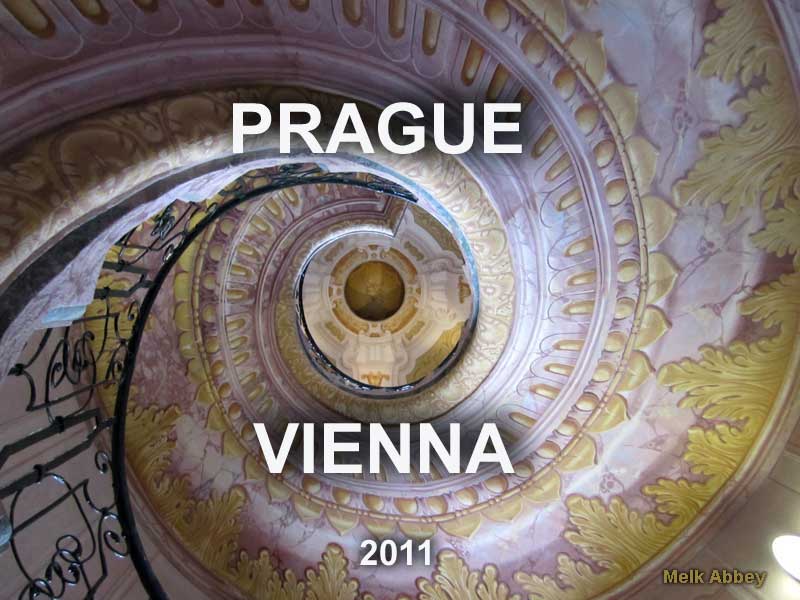

We arrived in Prague, or Praha (PRAH-hah) as the Czechs call their town, on the morning of Easter Monday 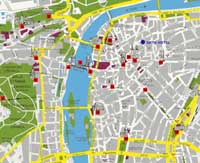 April 25 and headed straight for Antik Hotel (www.antikhotels.com) which was to be our base for six days. Ideally located and, as we soon discovered, within easy walking distance of most of the areas that we found interesting, we began quickly to refer to it as “home.”
April 25 and headed straight for Antik Hotel (www.antikhotels.com) which was to be our base for six days. Ideally located and, as we soon discovered, within easy walking distance of most of the areas that we found interesting, we began quickly to refer to it as “home.”

Not surprisingly, our room was not ready; so, we left our bags at the desk and headed for the old town square less than a 10 minute walk.

The square was filled with the Easter Market, with its festive decorations including huge decorated Easter eggs, trees covered with garlands, fluffy toy chickens, egg shaped balls, and garlands of spring flowers. The market had opened before Easter and, while having an Easter feel, was really a celebration of spring that would continue until the following Sunday (May Day). The food cooked in the stalls was local and, from what we sampled, delicious, and the music was lively and, indeed, festive. Our first stroll of the place introduced us to something that we came to appreciate about the town generally – it’s friendly, lively and enduring spirit.

 We briefly explored the old Josefoz area (also known as the old Jewish Quarter,) pausing before this rather unusual statue of one of the town’s most famous literary figures – Franz Kafka.
We briefly explored the old Josefoz area (also known as the old Jewish Quarter,) pausing before this rather unusual statue of one of the town’s most famous literary figures – Franz Kafka.
After a quick trip back to the hotel to check-in and settle into our room, we went back to the old town square for lunch at one of the outdoor cafes that surround the Square.
We had been awake a long time, having flown to Prague from Toronto via Frankfurt; so, after a brief nap, we headed out for an early supper at a place that was described in our Rick Steve’s guide as “a typical Czech pub with cheap, no-nonsense food”. Called Plzenska Restaurance u Dvou Kockek (“By the two cats),” it did have a local feel. With everyone around us speaking Czech (and us not understanding a word), an older fellow in the corner playing an accordion and singing (sometimes in English), it felt comfortable to be there. The food was wholesome and good – and the Czech beer was great! Nothing fancy but it was a spot to which we returned the next night and later, for a third time, before leaving..
The next morning, we slept in, missed breakfast and ran to the Square just in time to catch a 4 hour walking tour which was part of the PragueExperience package we had. Starting across the Vltava River, we explored the Castle area, the palace which is now the home of the President, St Vitas Cathedral , and then down the hill into Little Town with its many embassies.
It was a long, no-stopping kind of walk but a helpful introduction to the town and its long ago and more recent (20 th century) history.
One unexpected (for us) site was what is called the Lennon Wall – not “Lenin” (who is part of the history) but actually John Lennon, whose music was a source of hope – the graffiti spontaneously covered the wall right after Lennon’s death in 1980 and, until independence came in 1989, it was a gathering place for freedom fighters and local hippies. In the left-hand corner of the wall, is a small gate leading to a quiet courtyard with a lovely, peaceful outdoor café. We enjoyed a glass of wine and snack there when we returned to the area a few days later.
That night, weary from all the walking, which continued for us after the tour ended, we headed again for supper at “By the two cats.” (Admittedly, the name of the place and the sign featuring the two cats attracted us as much as did the locale and the food…We were missing our two cats).
On Wednesday, we got up early, had a pleasant breakfast in our hotel – great coffee and wonderful fresh fruit and rolls and cheese and eggs and meats. Then we headed straight for the Jewish Quarters, arriving before the ticket office opened (which, considering how busy it soon got, proved to be a good idea) to buy our ticket to the Jewish Museum of Prague (www.jewishmuseum .cz) and we spent several hours touring the old synagogues that now house displays that bring alive the history of the ancient and once large and thriving Jewish community that is now very small (about 5,000).
Prague's Jewish community is one of the oldest in Europe. The Old-New Synagogue (Staronová synagóga) which we visited later in the week, built around 1270, is the oldest working synagogue in Europe and one of Prague's earliest Gothic buildings. The area is rich in history, legend and tragedy. For instance, here, the story goes, Rabbi Loew created the Golem nearly half a millennium ago. Confined to a ghetto until 1781 when Josef II issued the Edict of Tolerance, allowing religious freedom. Slum clearing activities in the later 1800's led to most of Josefov being razed to the ground and only a few synagogues, the cemetery and the Josefov town hall remain. In the 30's and 40's, the Nazis all but annihilated Prague's Jewish legacy, saving the monuments as their planned epitaph to a vanished culture.
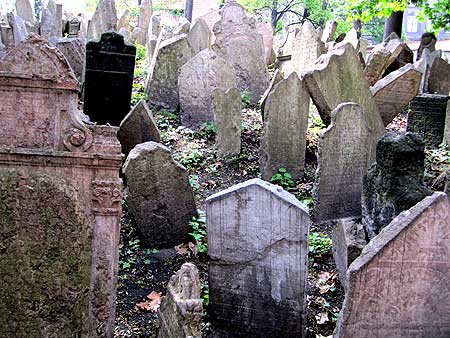 One
highlight was the Old Jewish cemetery (Starý židovský
hřbitov)with graves dating from the early 15th century. Founded in
1478, Old Jewish Cemetery is Europe's oldest
surviving Jewish cemetery. People had to be buried on top of each other
because of lack of space. There are about 12 layer and over 12,000 gravestones.
100,000 people are thought to have been buried here, the last one was
Moses Beck in 1787. The most prominent graves are those of Mordechai Maisel
and Rabi Löw.
One
highlight was the Old Jewish cemetery (Starý židovský
hřbitov)with graves dating from the early 15th century. Founded in
1478, Old Jewish Cemetery is Europe's oldest
surviving Jewish cemetery. People had to be buried on top of each other
because of lack of space. There are about 12 layer and over 12,000 gravestones.
100,000 people are thought to have been buried here, the last one was
Moses Beck in 1787. The most prominent graves are those of Mordechai Maisel
and Rabi Löw.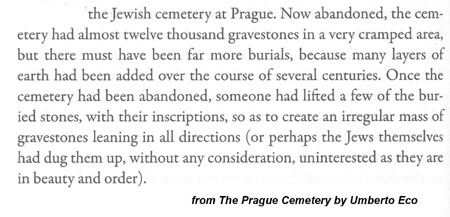
Feeling rather overwhelmed/oppressed by the reminders of Jewish history and suffering in the city, we decided to take a break and leave the tour of Old-New Synagogue for another day. We headed back to the lively Old Square and stopped at an outdoor Café run by the elegant U Prince Hotel (www.hoteluprince.com). George ordered steak tartar and I ordered a mushroom risotto. It was a fabulous lunch. And we realized that one of the great things about Prague was that it is a town with a true international flare – one that is reflected in a lively feel and in a wide array of culinary choices – not just Czech/German food but also great Italian, French, and Asian dishes.
That night we headed down to the docks to take a Dinner boat cruise on the Vltava River that bisects Praha. We started off not sure that we’d enjoy it but curious to see what it would be like. (We had always avoided doing touristy things like dinner cruises but this one had been included with our room rate in a hotel package that included free pick-up at the airport, the city tour, and this dinner cruise; so, we decided to give it a try). We managed to get seated at a table away from tour groups so that helped and it was a pleasant evening. We sat (pretty much on our own) out on the top deck to enjoy the ride down the river. The trip began in evening light; we headed slowly toward the locks and, when we’d gone through them, we headed back to our table for the buffet meal, enjoyed with a bottle of Czech wine. After dinner we headed back up to the deck to watch the return scene as soft darkness descended and Prague, including the Castle, lit up. We enjoyed the experience and agreed that, maybe, in the future we’d consider doing evening cruises – despite the touristy feel.


On Thursday, April 28, right after breakfast, we headed to the train station for a day trip to Kutna Hora, a lovely medieval town that grew rich and powerful because of silver mines and is now a popular day trip tourist destination because it is situated just and hour east of Praha by train. link
The weather had turned sunny and warm during our brief train ride and, by 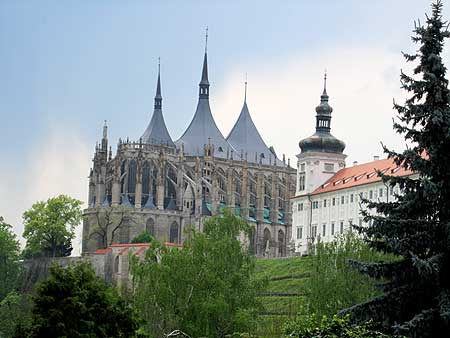 the time we arrived, we were feeling very overdressed in our sweaters, jackets and raincoats but, within half an hour, the weather had turned again and the grey skies threatened not just drizzle but serious rain. We stopped in the town square for a pizza and beer and then headed out (despite the threatening weather) to explore the town. It was a pleasant walk along winding streets up to The Cathedral of the Holy Virgin Barbara a magnificent gothic structure that had long dominated the town – the original miner’s chapel (consecrated to St. Barbara who is Patron Saint of Miners) having been built on the site around 1300.
the time we arrived, we were feeling very overdressed in our sweaters, jackets and raincoats but, within half an hour, the weather had turned again and the grey skies threatened not just drizzle but serious rain. We stopped in the town square for a pizza and beer and then headed out (despite the threatening weather) to explore the town. It was a pleasant walk along winding streets up to The Cathedral of the Holy Virgin Barbara a magnificent gothic structure that had long dominated the town – the original miner’s chapel (consecrated to St. Barbara who is Patron Saint of Miners) having been built on the site around 1300.

The weather unfortunately wasn’t improving so we decided to head down toward the train station and visit just one more site situated enroute - Sedlec Ossuary the Church of Bones, the oldest gothic church in Central Europe. It was built as part of the Sedlec Monastery and is famous now not only for its historical importance generally but also for its reminder of the inevitability of death and the value of the eternal through the decorative display of human bones. The cemetery here was, at the end of the 13 th century, sprinkled with earth brought from Calvary – giving the cemetery the reputation of hallowed ground and causing people to request to be buried here. As sections were taken apart, the bones were first piled in pyramids and then (in 1870) used to decorate the interior of the church.. It is estimated that the ossuary is the common grave of around forty thousand people.
After touring the church we travelled back to Prague by train and enjoyed a lovely dinner at the outdoor café of U prince in the square.
Friday, April 29th, was, of course, the day of the Royal Wedding; so, we were at the Old-New Synagogue, when it opened at 9am to do the tour before shifting our attention to this event. We arrived so early that, for a time, we were alone in the synagogue which is the oldest extant synagogue in Europe and has been the main synagogue of Prague for more than 700 years. Then, a guide arrived and graciously offered to tell us a bit about the history. (At that point we briefly regretted not being able to stay longer and learn more but we had to leave to claim our seats at the Royal wedding).
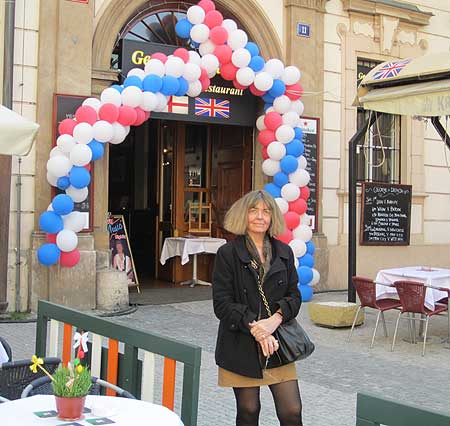
The previous day we had spotted a British Pub called ‘George and the Dragon’ (at the corner of the Old Square that was nearest to our hotel) that was putting up balloons and posting signs that they’d be opening early for the event; so, we headed there to claim our stools. It was quiet when we arrived but filled up quickly with an excited crowd of Royalty fans that was comprised mostly of Brits with their flags waving and their cameras pointed at the television screen and included a few Australians (and us lone Canadians). We ordered a pint (of British Ale of course) and then another and had a marvelous time. After the wedding ended, we stayed to have lunch at the pub, noting that the food was good and that it did feel more than a bit like being in a favorite pub in England. (There are lots of pubs in Prague that are English or Irish and that’s something that just gives another dimension to the wonderful town).
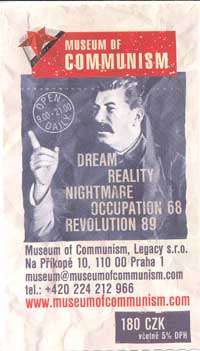
That afternoon, we shifted focus again, and went off to visit the Museum of Communism which tells the story of the post WWII Communist era – giving a good (and frightening) glimpse of life in Prague during the totalitarian regime from the February coup in 1948 to its rapid collapse in November 1989.
On our last day, George got up to take an early walk during which he could enjoy the beauty of Old Town before Prague woke up. This was a good time for picture taking:
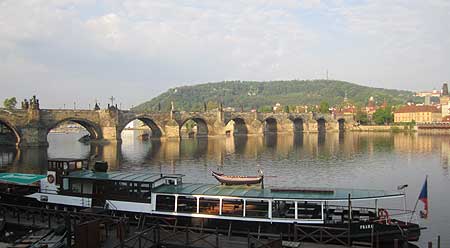
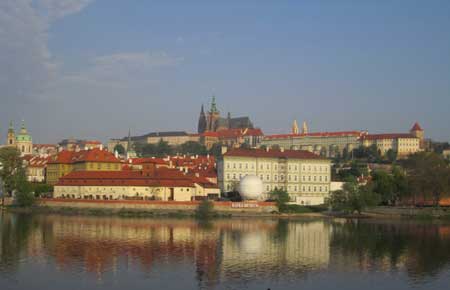
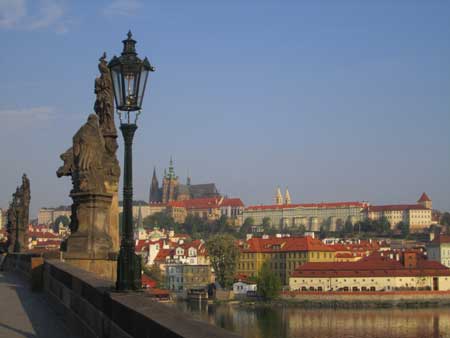
We decided to explore New Town. New Town isn't really new given that it was founded in 1348 by Charles IV just outside the city walls to the east and south of the then Old Town
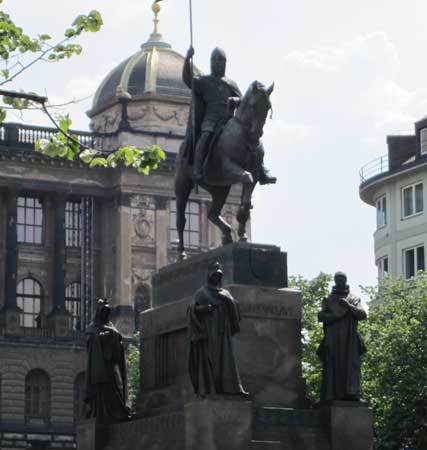 Leaving the Old Town Square with which we had become so comfortably familiar, we ambled our way to the centre of New Town – Wenceslas Squire which is not actually a square but rather a busy street of car traffic and busy pedestrians..Yes – there were some lovely buildings and wonderful huge statues, like this one of King Wenceslas (of Father Christmas fame) but we left feeling glad that we had chosen to stay in a hotel in Old, rather than, New Town.
Leaving the Old Town Square with which we had become so comfortably familiar, we ambled our way to the centre of New Town – Wenceslas Squire which is not actually a square but rather a busy street of car traffic and busy pedestrians..Yes – there were some lovely buildings and wonderful huge statues, like this one of King Wenceslas (of Father Christmas fame) but we left feeling glad that we had chosen to stay in a hotel in Old, rather than, New Town.
Enroute back to our hotel, we walked by the river and, crossing a bridge to the Island of Strelecky in the middle of the Vltava we spotted a lovely terrace of a restaurant called Strelecky Ostrov Czech Restaurant and stopped there to enjoy a great pasta meal with a glass of wine.
After resting our feet, we headed back to the U Prince hotel for a late dinner at what had become our favorite outdoor café on the Square. It was, as always, an excellent meal and this time the “entertainment” included thunder, lightning and sudden downpour.

Early on Sunday morning, May 1, we boarded the train that would, in 5 hours, take us from Prague (Praha) to Vienna (Wien). It was a pleasant ride through country towns and we enjoyed a lovely lunch in the dining car before reaching Vienna in the mid afternoon.

Our hotel, Hotel-Pension Suzanne was located inside the Ring (within the Inner City) just a half block from the State Opera. We settled in to our room and set out to explore Vienna. Since it was Sunday, most shops were closed; so, we were missing the vibrant, colorful spirit of Prague and noticing that everything – the buildings and the statues - however magnificent they may be, looked depressingly grey. We strolled to Stephansdom, said to be the soul of the city, and went back to the room to study our guide book, ‘Eyewitness Travel,’ to figure out what to do with our days in Vienna.

That evening we had dinner at restaurant called the Goulash Museum where George enjoyed a chicken liver goulash and I had a vegetarian version of goulash made from a variety of mushrooms.
The next morning, May 2, we had a good breakfast at our hotel and headed to the Freud Museum which is located at Berggasse 19 – the house where, in 1891, Freud established his medical practice and where, until driven into exile in England, he conducted his analyses and wrote his most important work. Both of us felt a bit like pilgrims reaching a sacred site; so, we walked slowly through each room, stopping to look at his personal possessions, photographs, books, and art and to read quotes that illustrated, and brought back to life, his complex character. We had, several years ago, visited the house that had been his home in England and we were, on this trip, reading a series of novels by Frank Tallis that are set in the Vienna of Freud’s era and in which a young psychoanalyst, who meets frequently with Freud at his house at Berggasse 19, helps a detective friend to solve murder cases. So, the visit here was a highlight of our stay in Vienna.
George stands at the open door of the house that had been the home (and office) of Sigmund Freud. To the right is the reception room where Freud held his Wednesday night group that came to be called the Wednesday Psychological Society.
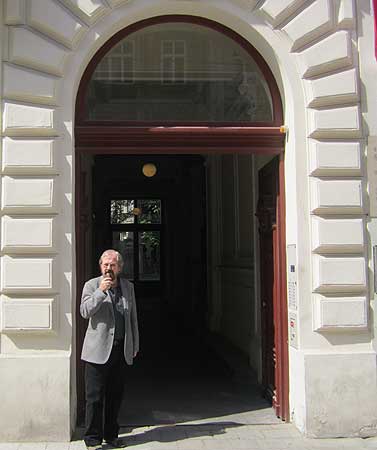
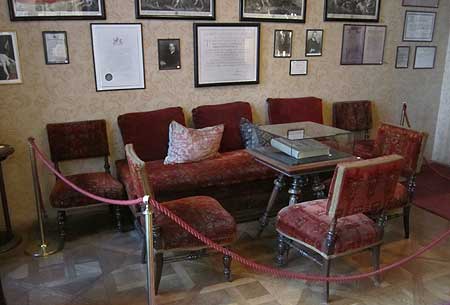
On our walk back to our hotel, the sky cleared and, as we walked though Stadt Park, we were beginning to appreciate the city.
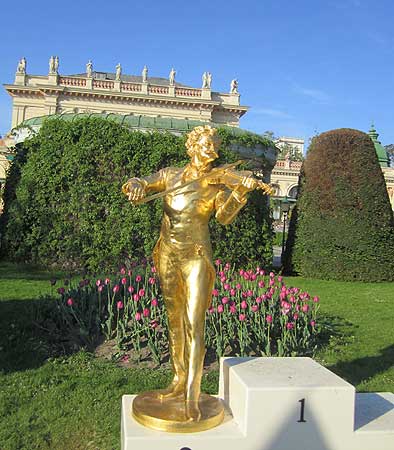
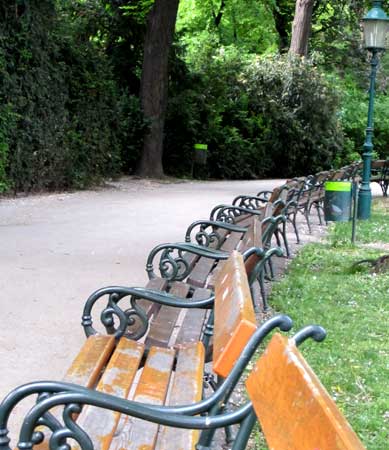
Having had a late pub lunch and then heading back to our hotel, it was quite late in the evening when we went in search of a place to have light dinner and discovered what was to be a second highlight of our visit to Vienna – a restaurant called Nautilus Fischrestaurant (www.nautilus-fischrestaurant.at) that was located in the Naschmarkt, which in the daytime is the site of Vienna’s active market. We were attracted to it by the liveliness of the place – an outdoor café type atmosphere with heat lamps to allow one to sit outside late into the night. We got into the good mood – enjoying a couple of glasses of wine and food that was fabulous – a wonderfully fresh arugula & tomato salad for me and a small fish platter for George. We sat there till well past midnight and left, looking forward to our next visit.
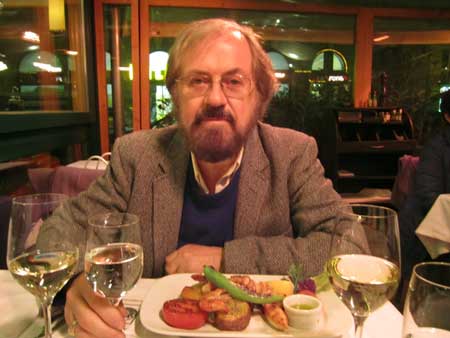
The next day, May 3, was a rainy day so we headed down, before the rain started, to see the Naschmarkt in the daytime and then visited a couple of art museums, including the Seccession Building which houses the work of Gustav Klimt.
Then, we walked over to a very popular restaurant called Figlmueller which, still family run, was founded in 1905 and is famous for its authentic (very thin) schnitzel. It was, as it always is, very busy but we soon got a table, ordered beers and George decided on the breaded sweetbreads, figuring that he’d return for a schnitzel dinner when he was very hungry (as the plates were huge with the wonderful looking schnitzel so big that it hung over the edges) and I had a breaded cheese dish that I enjoyed but found very heavy. 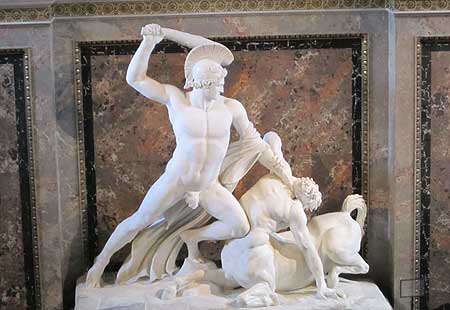
After lunch we headed over to the Hopberg to see the Kunsthistorisches Museum. The building was impressive – especially the marble but the exhibits were disappointing primarily because we had gone there specifically to see the Archimboldo paintings only to find that they were currently on loan to another museum.
That evening, we watched (briefly) the Homage to Jerome Robbins ballet adaptation of Philip Glass which was being broadcasted live on a screen outside the State Opera House Unimpressed, we left pleased not to have bought tickets

The evening concluded at the Museum Café for coffee and Sachar Torte, the famous chocolate cake from Austria, invented in 1832
Next morning right after breakfast, we headed to the train station and boarded a train for Bratislava, Slovakia. It was a quick trip (just over an hour) but not picturesque as, for most of the ride, we were traveling though the suburbs of Vienna.
We had recently discovered that the World Cup Hockey tournament was taking place at that time in Slovakia and the city of Bratislava was caught up in the excitement of the games.
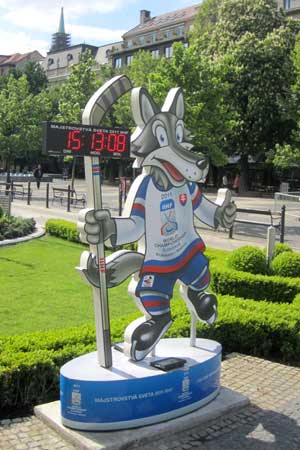

Each competing nation had, somewhere in the city, a statue representing that nation. We found the Canadian one right outside the Bratislava Opera House. Unfortunately the Canadian team was not playing in Bratislava but rather in the town of Kosice which was several hours away. Canada did very well in the qualifying games in Kosice and did eventually arrive in Bratislava unbeaten but then only to play one game and lose to the Russians. (But that was after we had returned home).
We wandered though Bratislava mainly enjoying the hockey excitement but also taking note of sites such as these unusual statues:
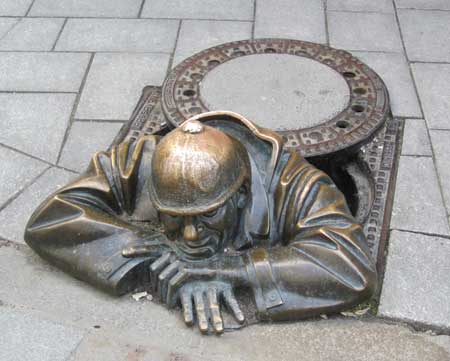
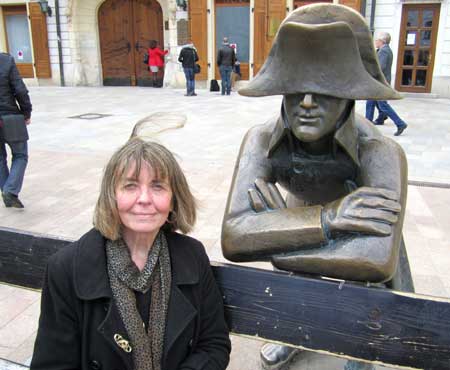
We did a tour of the city and castle but the most memorable part of the day was the hockey tournament excitement. We regretted not having gotten to a live game but we did relax for a while to watch a televised game in a bar called Café Marrakech where George drank Absinthe and I enjoyed a glass of Slovakian wine.
We took the train back to Vienna, getting to our hotel about 8pm and headed out for a late night supper at Nautilus. This time George was hungry so he had the large fish platter and I ordered a simple olive oil & peppers pasta with my arugula salad. We both drank wine, shared a dessert and ended the meal with grappa.
On Thursday, we took the train from Vienna to Melk, enjoying the view of quaint Austrian towns and farmland along the way. When we arrived in Melk, we headed straight to the Melk Abbey (www.stiftmelk.at), a Baroque monastery situated on a rock overlooking the Danube, in which Benedictine monks have continually been living and working since 1089.
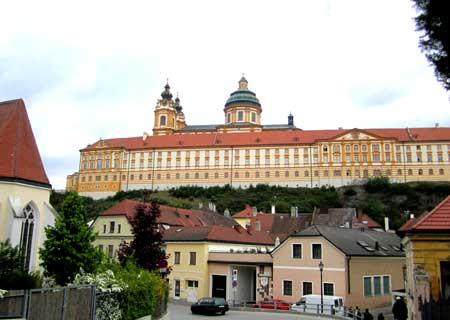

Following the rules of St. Benedict, they still try to translate into action the words ORA et LABORA et LEGE (pray and work and read) by providing pastoral care for 23 parishes and a secondary school with about 920 pupils. The abbey museum contains the exhibition “The Path from Yesterday to Today” which makes use of art treasures and multi-media means to tell the story of the monastery’s 900 year history in a modern way. The experience of walking through the rooms of this exhibition is, for want of a better word, profound; it is brilliantly and beautifully done, giving a sense not only of the history but also of the meaning of life and death as experienced by the generations of Benedictine monks. And the same can be said of visiting the library and the church – and simply looking at the building – and at the views to be seen from it.
Melk Abbey is the monastery that is the setting for Umberto Eco’s book “The Name of the Rose;” it is also the setting for the movie based on that book. It’s a favorite movie; so, soon we’ll watch it again.

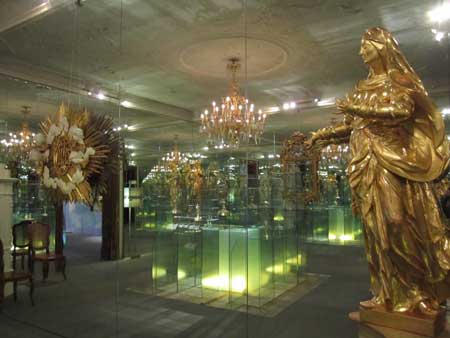
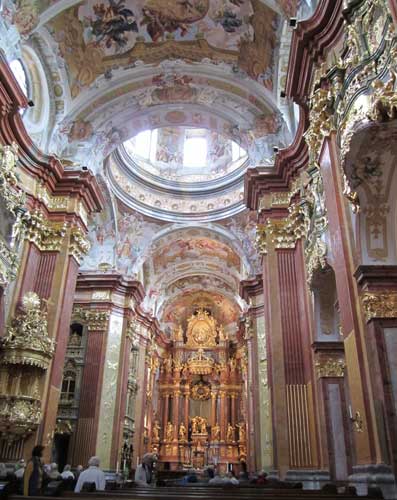

The Abbey comes complete with its own skeletons
Melk itself is a lovely town and we were tempted to stay there, have lunch and wander some more but we wanted to take a cruise down the Danube so we had lunch on the boat as we headed to Krem. We sat out on the deck for much of the time, watching the hills of vineyards, the castles and the small towns. The cruise reminded George of his experience of going down the Rhein many years ago - with ruined castle peering down from high crofts and vineyards stretching up the hill sides
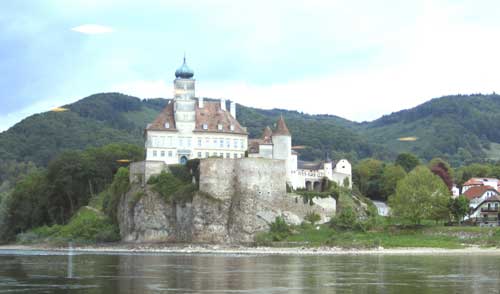
Shortly before reaching Krem, which we intended to explore before taking the train from there back to Vienna, we were struck by the beauty of a small town called Dürnstein on the Danube. When our boat docked there briefly, we both thought of getting off but instead, regrettably, remained on board. We quickly discovered that there was nothing worth exploring in Krem so we took a bus ride back to Durnstein. We enjoyed the ride which took us through lovely fields, vineyards and villages and we had just a brief time to look around Durnstein before taking the bus back to Krem and boarding our train back to Vienna.
That night we had dinner at Figlmueller where George ordered the fabulous schnitzel.
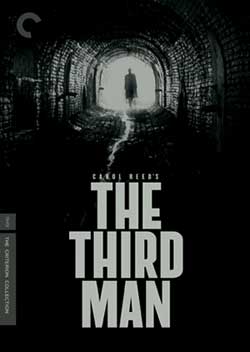 On our last day in Vienna, the weather was improving and the sun came out so we walked again to some of our favorite places, mainly around the Hopsberg, had a drink and a dessert at the famous and in, the late afternoon we did a 3-hour Walking Tour focused on the famous Vienna cult movie, scripted by Graham Green and starring Orson Welles, “The Third Man.” The tour took us through places where the movie was filmed and provided some glimpses of what life was like in Vienna in the era of Cold War espionage. The movie, according to our guide, is an accurate portrayal of those days. We now have a copy of the movies and plan to watch it tonight. Listen to its Famous Theme Song
On our last day in Vienna, the weather was improving and the sun came out so we walked again to some of our favorite places, mainly around the Hopsberg, had a drink and a dessert at the famous and in, the late afternoon we did a 3-hour Walking Tour focused on the famous Vienna cult movie, scripted by Graham Green and starring Orson Welles, “The Third Man.” The tour took us through places where the movie was filmed and provided some glimpses of what life was like in Vienna in the era of Cold War espionage. The movie, according to our guide, is an accurate portrayal of those days. We now have a copy of the movies and plan to watch it tonight. Listen to its Famous Theme Song
After the tour, we went back to our hotel to pack so as to be ready for an early departure in the morning and, then, for one last time headed to the Nautilus for a late farewell supper.
